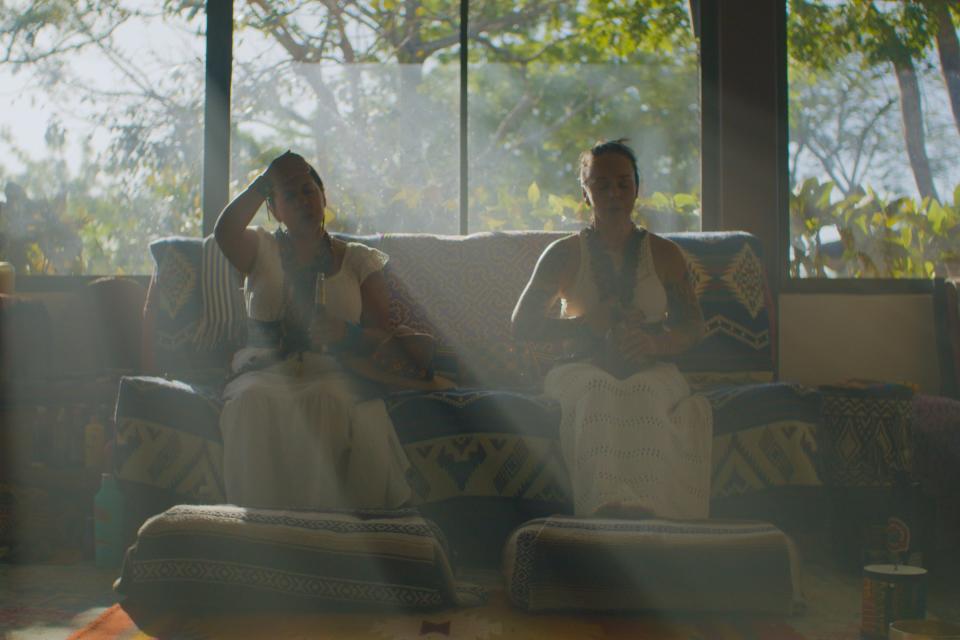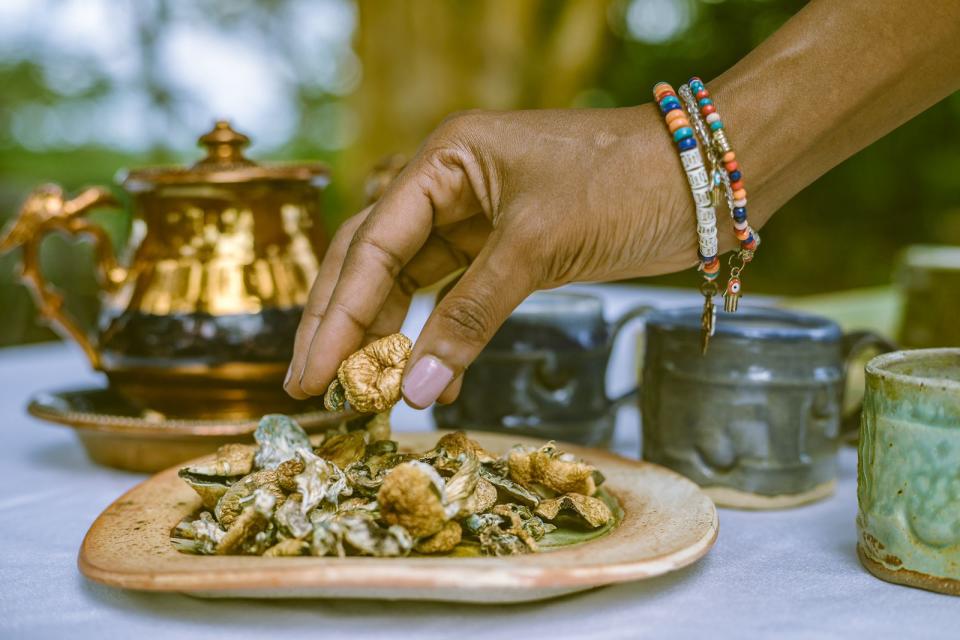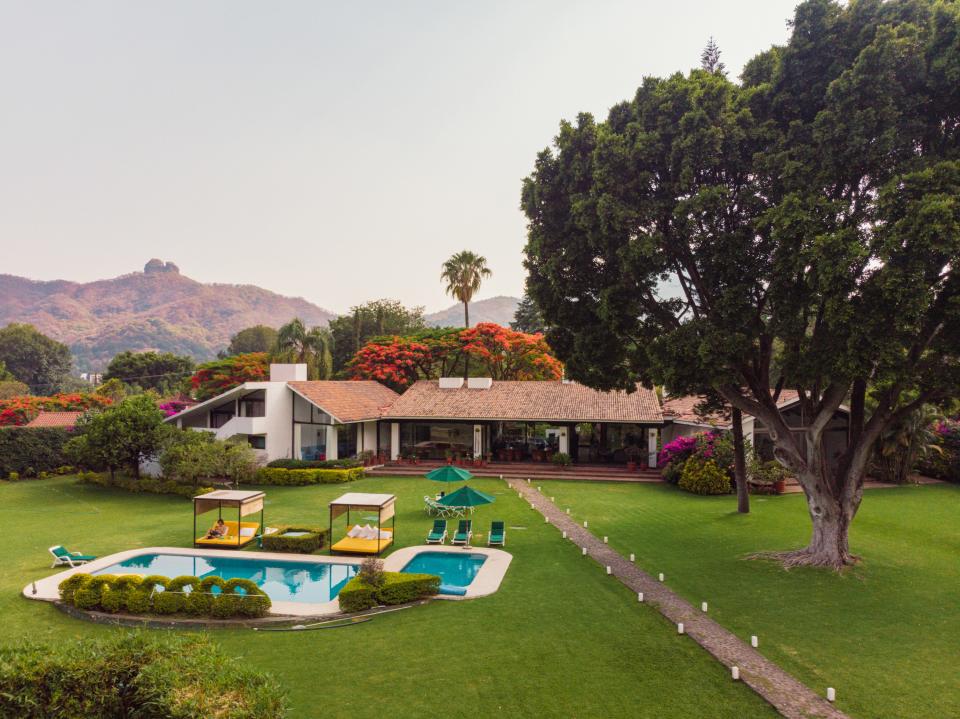Psychedelic Travel Experiences Are More Popular Than Ever

Beckley Retreats
In a mountain town about three hours outside of Mexico City, I sat on the floor of a thatched-roof palapa with blankets wrapped around me as a facilitator (both a researcher and medicine woman) sang soothing chants. A few hours earlier, I had declared my intention for our ayahuasca journey—that I want to live a big, meaningful, impactful life and am willing to release anything that does not serve that vision. By the end of the ceremony, where I took about three cups of the brew during the six hours between sunset and dawn, the message I received was that life is meaningless—that I might as well do whatever I want while I’m here.
To say that I was a little confused and discouraged by that would be an understatement. But eight months later, in a ceremony centered around a different substance—5-meO-DMT, more often called bufo, a substance derived from the parotoid glands of the Bufo Alvarius toad and widely regarded as the most powerful psychedelic in the world—in Tandava Retreats in Tepotzlán, I received the other half of that message. By way of what can only be described as full and total ego death, I came out of the hour-long ceremony with what felt like temporary enlightenment: That we are all given this chance to be human only once, and that we are born from the same place and will return to that place. Even if we can’t rationalize the meaning of life, we might as well live it to the fullest.
According to experts, I’m not alone in my interest in psychedelic retreats. Tommaso Barba—a Ph.D. candidate at Imperial College who has collected survey data from people who have participated in psychedelic retreats and ceremonies—says psychedelic retreats are becoming increasingly popular. Why now? Because a growing body of research into the therapeutic benefits of long-illegal psychedelic compounds is becoming widely available, making their therapeutic use less stigmatized for the first time.
“For most participants, psychedelics aren’t accessible where they live, which makes psychedelic retreats enticing, especially in countries where each substance is either legal or operates in a gray area,” says Barba.
According to his research, the most popular psychedelic retreats are psilocybin (hallucinogenic mushroom) experiences, offered in South America and the Netherlands, where the drug is legal; ayahuasca (a plant containing the powerful psychoactive DMT) ceremonies in South America, where it is considered an indigenous medicine; and bufo in Mexico, where the substance may be consumed. (As of now, there are no countries where LSD- and MDMA-assisted therapeutic retreats are legal, but according to MAPS, the non-profit Multidisciplinary Association for Psychedelic Studies, that may soon change.)
Here’s what travelers new to the psychedelic space can generally expect from a ceremony or retreat with each compound. Travelers taking on these experiences should do their research and do so only with a trained expert or retreat company they have thoroughly vetted—one they trust. The journey will vary depending on where you go and who you choose to be your guide.

Ayahuasca (DMT)
Ayahuasca is usually made from the combination of two or more plants that have historically grown in abundance in the Amazon jungle and can be grown in similar climates around the world: the ayahuasca vine (Banisteriopsis caapi), and the chacruna leaf (Psychotria viridis), which contains the powerful psychoactive DMT (N,N-dimethyltryptamine). The mixture is made into a brew, often consumed in the form of a tea, that induces altered states of consciousness. The word ayahuasca comes from the Quechua of Peru and translates to “vine of the soul” or “vine of the spirits.”
The experience: Most ceremonies take place in a maloca, a wooden structure with a thatched roof, and can range from one-night events to multi-day dietas. They usually begin at sunset and end the following morning before dawn, lasting around five to six hours. Participants often drink around three cups of ayahuasca—each about the size of an espresso shot—throughout the night as shamans and healing elders sing icaros, or prayers through song, to facilitate a sense of calm and tranquility. Although every ayahuasca experience is different, most are known to elicit intense visuals, with many participants reporting that they seemed to travel back in time, through eras and lineages, to meet their ancestors. There are also intense bodily reactions: crying, screaming, and purging. Several vetted healing centers throughout Costa Rica offer ayahuasca experiences, including Rythmia, Reunion, and the Soltara Healing Center, which also leads retreats in the Peruvian Andes and the Amazon, one of the vine’s homelands.

Mushrooms (Psilocybin)
Certain types of mushrooms contain psilocybin, a naturally occurring, psychoactive chemical found in various species of fungi that grow predominantly in the Americas. Though the use of mushrooms to alter consciousness, invoke healing, and engage in religious and spiritual ceremonies spans the globe and goes back thousands of years—most notably in pre-Columbian cultures such as the Maya, Aztec, Olmec, Mazatec, and Zapotec—it’s now being studied and used in more scientific and therapeutic ways, too. According to the International Journal of Medicinal Mushrooms, psilocybin is one of the most funded and researched plant medicines. In 2020, Oregon became the first state to approve the adult therapeutic or wellness use of psilocybin, with Colorado legalizing psilocybin in 2022, with more states set to follow.
The experience: Usually offered in small communities as a self-reflective, introspective modality of healing, traditional psilocybin ceremonies in Mexico begin with a temazcal, or sweat lodge ceremony dating back to Mesoamerican civilizations. Participants are then guided to an outdoor area, usually positioned around a fire pit, to eat the psychedelic mushrooms in their raw form. The mode of consumption varies around the world; for example, during ceremonies with Beckley Retreats in Jamaica, psilocybin is consumed through ginger-lemon tea. Facilitators play live music throughout the experience, which usually lasts around six hours.
Also in Jamaica is MycoMeditations, where all prospective guests undergo a thorough medical screening to ensure they are a good fit for a psilocybin retreat. Other companies leading the field are the Jamaican-owned ONE Retreats by Rose Hill, the largest natural psilocybin producer and the first legal exporter for both researchers and retreat centers, and MycoMeditations, a facility that administers a three-dose protocol in a retreat setting over a one-week period.
Peyote or San Pedro (Mescaline)
Traditionally consumed in religious ceremonies by Indigenous communities throughout the desert plains of northern Mexico and the southwestern United States, peyote is a circular cactus that contains the hallucinogen alkaloid mescaline. It is the sacramental medicine of the Native American Church, and was relegalized under federal law in 1994 as an amendment to the American Indian Religious Freedom Act of 1978. The top of the cactus contains buttons, which are consumed fresh or dried, are often smoked like tobacco or made into a powder that can be consumed as tea. The San Pedro cactus, which has been used for thousands of years by Andean communities in northern Peru, also contains mescaline and can be consumed for similar medicinal purposes.
The experience: Considered the most gentle of the plant medicine experiences, peyote elicits visual effects in a softer, less confronting manner than ayahuasca and psilocybin. Ceremonies tend to follow similar protocols as ayahuasca and psilocybin and are often done outside, in nature, and around a fire. Participants undergo a set of cleansing rites before they begin their journey with peyote, and are usually given around three opportunities to consume more if desired. Though most Peyote ceremonies occur within closed community groups, there are a few retreat experiences available with the Wixarika community. During a 10-day pilgrimage, participants are invited into the sacred land of the Wixarika people (or Huichol), in the Wirikuta Desert of northern Mexico, where they participate in collecting the medicine and preparing it for use before the ceremonial rites begin.

Bufo (5-meO-DMT)
Deriving from the parotoid glands of the Sonoran Desert toad—also known as the Bufo Alvarius toad or the Colorado River toad—the compound 5-MeO-DMT, also known as bufo, is a potent psychedelic. While many practitioners believe it’s best to take the secretion directly from the toads, this practice can harm the amphibian, often resulting in its death. That, combined with the fact that drug cartels have been linked to both illegal and unethical harvesting of the toad for the substance, has led to the re-popularization of synthetic bufo, a safer, more ethical alternative that allows practitioners to properly measure dosages.
The experience: Widely regarded as the most powerful psychedelic in the world, the 5-MeO-DMT experience is singular in its effects. It is not known to elicit visuals as other psychedelics like psilocybin, ayahuasca, or peyote do. Instead, bufo, often called the God Molecule, is known for an effect of complete dissolution, also known as ineffability, where the participant forgets they are a human, or even have a human body or consciousness. Participants often leave with feelings of a deep interconnectedness between themselves and the universe—as if everything is nothing, and nothing is everything.
About an hour outside of Mexico City, in the mystical mountain town of Tepoztlán, Tandava Retreats, helmed by CEO and Founder Joel Brierre and Head of Education Victoria Wueschner, leads groups or individual clients on four-night bufo experiences. Daily breathwork, meditation, and yoga are held in addition to two privately facilitated ceremonies. Each participant can also take advantage of included post-retreat sessions with an integration specialist to further dive into their medicine experience and decipher what it could mean.
Originally Appeared on Condé Nast Traveler

